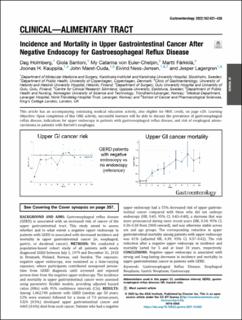| dc.description.abstract | Background and Aims
Gastroesophageal reflux disease (GERD) is associated with an increased risk of cancer of the upper gastrointestinal tract. This study aimed to assess whether and to what extent a negative upper endoscopy in patients with GERD is associated with decreased incidence and mortality in upper gastrointestinal cancer (ie, esophageal, gastric, or duodenal cancer).
Methods
We conducted a population-based cohort study of all patients with newly diagnosed GERD between July 1, 1979 and December 31, 2018 in Denmark, Finland, Norway, and Sweden. The exposure, negative upper endoscopy, was examined as a time-varying exposure, where participants contributed unexposed person-time from GERD diagnosis until screened and exposed person-time from the negative upper endoscopy. The incidence and mortality in upper gastrointestinal cancer were assessed using parametric flexible models, providing adjusted hazard ratios (HRs) with 95% confidence intervals (CIs).
Results
Among 1,062,740 patients with GERD (median age 58 years; 52% were women) followed for a mean of 7.0 person-years, 5324 (0.5%) developed upper gastrointestinal cancer and 4465 (0.4%) died from such cancer. Patients who had a negative upper endoscopy had a 55% decreased risk of upper gastrointestinal cancer compared with those who did not undergo endoscopy (HR, 0.45; 95% CI, 0.43–0.48), a decrease that was more pronounced during more recent years (HR, 0.34; 95% CI, 0.30–0.38 from 2008 onward), and was otherwise stable across sex and age groups. The corresponding reduction in upper gastrointestinal mortality among patients with upper endoscopy was 61% (adjusted HR, 0.39; 95% CI, 0.37–0.42). The risk reduction after a negative upper endoscopy in incidence and mortality lasted for 5 and at least 10 years, respectively.
Conclusions
Negative upper endoscopy is associated with strong and long-lasting decreases in incidence and mortality in upper gastrointestinal cancer in patients with GERD. | en_US |

